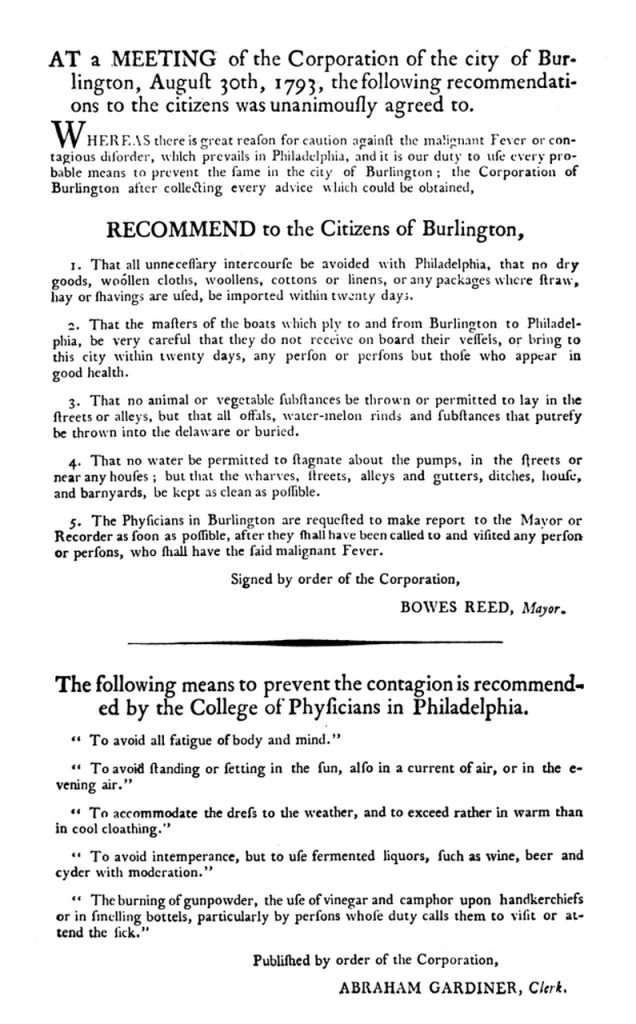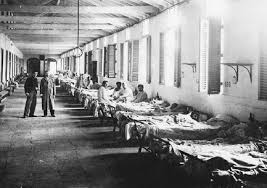1793

It was the month of August in the year 1793. Philadelphia was the country’s largest city and the capital of the USA. Philadelphia housed 50,000 people in tight houses that were laid out near the river.
French Refugees along with their slaves were coming into the US from San Domingue (Haiti). These Caribbean immigrants were carrying a deadly virus with them, unbeknownst to them. The virus was transmitted by mosquitoes from one human to another. But, at the time no one thought of mosquitoes as the spreaders. Only later, 100 years after the outbreak – Scientists and literati deduced the facts.
Yellow fever, or The American Plague (as it was known at the time), is a viral disease that begins with fever and muscle pain. Next, victims often become jaundiced (hence, the term “yellow” fever), as their liver and kidneys cease to function normally. Some of the afflicted then suffer even worse symptoms. Famous early American Cotton Mather described it as “turning yellow then vomiting and bleeding every way.” Internal bleeding in the digestive tract causes bloody vomit. Many victims even become delirious before dying.
The summer of 1793 was one of the hottest in Philadelphia. Humidity was unbearable. The streets of Philadelphia were mostly empty, for people were afraid to go out. The estimated deaths during the time of August to October were nearly 5,000, and 20,000 people had fled the Capital of the U.S. – Philadelphia. The rich(including George Washington and Thomas Jefferson) fled to the countryside, the poor and indifferent stayed in and eventually fell sick. In a few months, 10% of the population was wiped out. It was in October when it peaked and gradually it started to decrease.
The yellow fever got its name from the symptoms that the infected people manifested. They had yellow skin and eyes, purple blotches, internal hemorrhages, black vomits and high fever.

Nobody knew what was happening – one day a person was healthy, and the next day he was gone. People were praying for a cure.They could attribute the sickness to only ONE thing – refugees.People believed that French refugees coming from Saint Domingue(Haiti) who were entering the US were bringing the disease with them, because the onset of the disease started with the arrival of the refugees.
The refugees were expected to quarantine for 21 days in the ship. Quarantining was difficult and quarantining also showed that refugees became very sick inside the ship. This further cemented the belief that this disease was indeed coming with the refugees.

Dr. Benjamin Rush: the physician who combated the yellow fever advised people to flee the city . He said, “unusual number of bilious fevers, accompanied with symptoms of uncommon malignity.” He concluded that, “All was not right in our city.”
He attributed the disease to unsanitary living conditions. People of Philadelphia wanted to blame the refugees of Saint Domingue; Dr. Rush thought that yellow fever was a result of open sewage, rotten vegetables and extremely hot temperatures.
He led a cleanliness effort to clean the city, and he also thought that the free blacks of the city were immune to the disease, so he asked them to be on the frontline helping the sick.
Besides cleanliness, his suggested cure for yellow fever was even more bizarre.
He surmised the blood of the diseased humans had got infected, so he used the “bleeding-purging” method. Sometimes, ⅔ of infected blood was removed from the sick person. His methods were all unproven and proved fatal for the patients. But his avid conviction in his methodology bestowed hope in the dying population. Those who opposed his methodologies called him a killer and a murderer.
As winter started to set in, lakes started to freeze and slowly the pandemic started to ease. The first frost killed many of the pesky mosquitoes, and the superspreaders stopped spreading the disease.
Nobody still knew what caused the yellow fever. It was one newspaper that noted that the cold weather is leading to a decrease in mosquitoes.
It would be 1881 nearly 90 years after when yellow fever was attributed to mosquitoes.
Even then what was a Public Health Issue became a political one : As yellow fever consumed Philadelphia, politicians debated the disease’s origins, its treatment, and preventative measures. Secretary of the Treasury Alexander Hamilton, a prominent Federalist, believed that newly arrived, white, French refugees fleeing the revolution in Santo Domingo (now Haiti) were the source of the disease. Hamilton and other Federalists favored actions like closing the ports and restricting immigration to stem the epidemic. By publishing his opinions about the epidemic and its treatment in newspapers, Hamilton turned what had been a medical question into a political dispute.
Yellow fever changed Philadelphia forever – hospitals were built to care for the sick, open sewers were closed, laws were made which enforced citizens to keep their dwellings clean.
Even though Dr. Benjamin Rush’s (he was born on the same day as Dr. Fauci) diagnosis for yellow fever was inaccurate, he paved a way for hospitals, and also established the first free dispensary in the United States.
During the period of the American Plague, people were afraid of each other, afraid to meet friends, afraid to shake hands with others. Would COVID-19 leave us like this?
Sources : https://en.m.wikipedia.org/wiki/1793_Philadelphia_yellow_fever_epidemic
http://www.eyewitnesstohistory.com/yellowfever.htm
And several other videos.